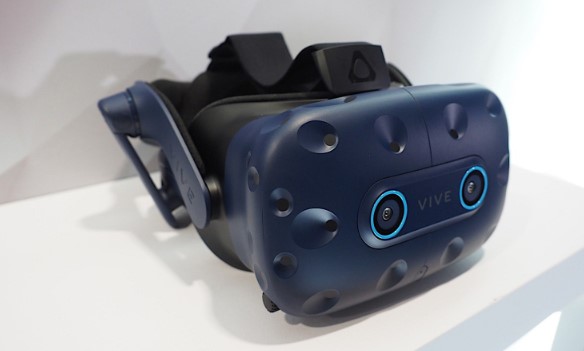
HTC’s newest Vive Pro headset adds just one feature to the existing hardware, but it’s a doozy — integrated eye-tracking. Using Tobii technology, the Vive Pro Eye is able to follow users’ eyeballs in real-time, letting developers gather data on exactly where they’re looking and when, and opening the door for new, more immersive experiences. But eye-tracking isn’t just a clever input method. Its existence also enables foveated rendering, a technique that essentially means VR is about to get a lot prettier.
Foveated rendering allows developers to focus their skills in a single area at a time — namely, exactly where the player is looking. The area around the user’s direct gaze is blurred, which means there’s more processing power to make whatever the person is actually looking at as sharp as possible. Foveated rendering mimics the way the human eye works naturally (good luck trying to look at your blurry spots right now), so it’s not even noticeable when it’s in action. All the player sees is a cleaner, more realistic image, while everything else fades into the background and is filled in by the brain.
The Pro Eye improves upon the Pro’s rendering capabilities nine-fold, according to ZeroLight technical director Chris O’Connor. ZeroLight was at CES showing off its car-customization and -shopping software on the Vive Pro Eye, and O’Connor let me see the developer side of things while I had the headset strapped on (which still fits and feels just peachy, by the way).
In the demo, I got to customize a BMW M5 on a sunny day in the middle of an empty racetrack, selecting color, wheels and other details. The environments and car were incredibly crisp, even when I leaned in closely to examine specific parts. At one point, I found myself in the driver’s seat, staring at the shining metal BMW logo on the steering wheel.
With debug mode on, I was able to see standard Vive Pro rendering on the left side of the screen, and Pro Eye rendering on the right. The difference was immediately clear — the standard image was pixelated and duller, while the Pro Eye image looked like butter. The logo shone without a pixel in sight, while the leather looked soft to the touch.
The eye-tracking never short-circuited (that I noticed, at least) and the headset seemed to have no problem following my gaze, no matter how rapidly I looked around. And then there was all of the data collected by the eye-tracking system — after inspecting my car, a heatmap and graphs showed where I focused most of my attention.
ZeroLight builds software to help companies sell cars, and the Vive Pro Eye is a big benefit to this business. Have a customer build their dream vehicle, and at the end, the sales associate can see what areas they’re most interested in or whether they lingered over a certain product, all to better upsell them.
I also tried out Ovation, a public-speaking training course that tracked my eye movement over a crowded hotel conference room as I gave a prepared speech. At the end of that session, pages of gaze- and speech-related data popped up, designed to help me improve my speaking skills.
There’s a clear trend already — these aren’t games. HTC decided to build a headset with eye-tracking because of requests from their enterprise customers. These companies use the Vive Pro to train employees, improve processes, test new ideas and sell more products, and eye-tracking can be a benefit to all of these areas.
“I think last year, we made it very clear to the industry that we were going to support and service enterprise and professional customers,” HTC Vive Americas General Manager Dan O’Brien said. “Because not only they were wanting it, but this is a very healthy place for us to go, and for VR.”
Of course, eye-tracking and foveated rendering can be huge benefits for gaming and entertainment experiences as well, and developers will surely hop on board now that the Pro Eye has been officially unveiled.
HTC also unveiled the Vive Cosmos during its CES press conference, though it didn’t share many details about this new headset. It’s consumer-focused, designed to be comfortable and easy to use, and it runs on both a PCs and smartphones in some way. Whatever it ends up finally being, the Cosmos represents HTC’s commitment to the consumer market, not just enterprise.
“We do think that both are very important,” O’Brien said. “You will continue to see consumer products from us… you’ll continue to see premium VR extended and what we can do with that as well. We believe both of these avenues are really, really important and we’re not going to pivot away from one for the other.”
